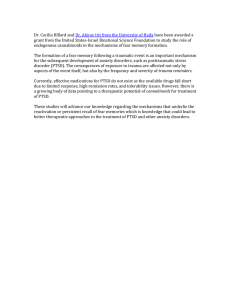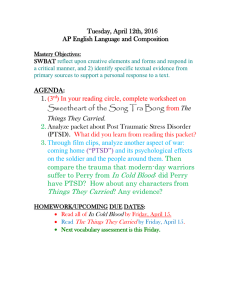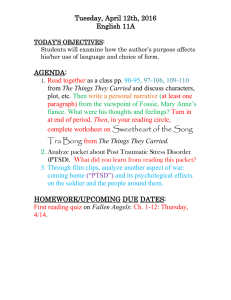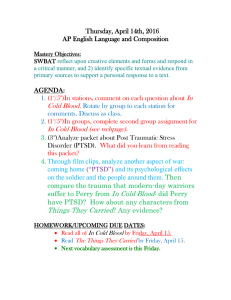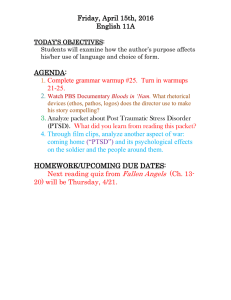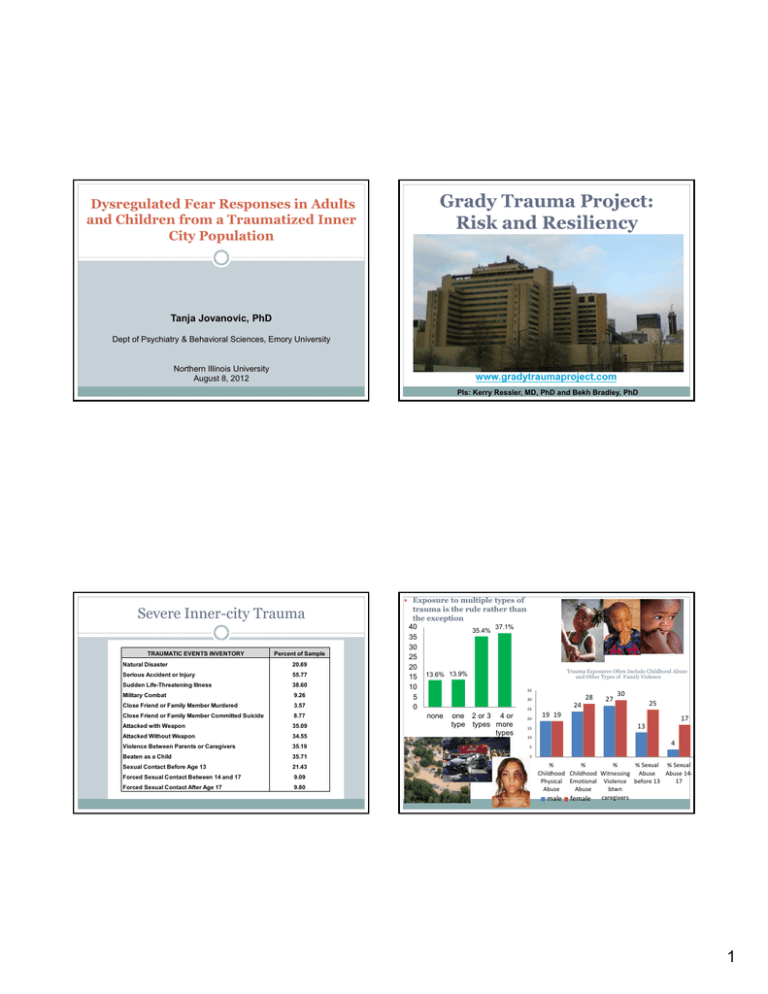
Dysregulated Fear Responses in Adults
and Children from a Traumatized Inner
City Population
Grady Trauma Project:
Risk and Resiliency
Tanja Jovanovic, PhD
Dept of Psychiatry & Behavioral Sciences, Emory University
Northern Illinois University
August 8, 2012
www.gradytraumaproject.com
PIs: Kerry Ressler, MD, PhD and Bekh Bradley, PhD
Exposure to multiple types of
Severe Inner-city Trauma
TRAUMATIC EVENTS INVENTORY
Percent of Sample
trauma is the rule rather than
the exception
37.1%
40
35.4%
35
30
25
20
15 13.6% 13.9%
10
35
5
30
0
25
none one 2 or 3 4 or
20
type types more
15
types
Natural Disaster
20.69
Serious Accident or Injury
55.77
Sudden Life-Threatening Illness
38.60
Military Combat
9.26
Close Friend or Family Member Murdered
3.57
Close Friend or Family Member Committed Suicide
8.77
Attacked with Weapon
35.09
Attacked Without Weapon
34.55
Violence Between Parents or Caregivers
35.19
5
Beaten as a Child
35.71
0
Sexual Contact Before Age 13
21.43
Forced Sexual Contact Between 14 and 17
9.09
Forced Sexual Contact After Age 17
9.80
10
Trauma Exposures Often Include Childhood Abuse
and Other Types of Family Violence
28
24
27
30
25
19 19
17
13
4
%
%
%
% Sexual % Sexual
Childhood Childhood Witnessing Abuse
Abuse 14‐
Physical Emotional Violence before 13
17
Abuse
Abuse
btwn
male female caregivers
1
Case example 1 (8622)
Case example 2 (8543)
T.D. is a 33 y/o AA female. From the age of six, she has
sustained severe physical and emotional abuse by her father
and repeated sexual abuse by her step brother. She was
unwilling to talk about any of her traumas, but has significant
symptoms of PTSD. She is also drinking about a 6 pack a day
and is currently using cocaine. She has no close relationships
with any of her family members. She has no friends, no
hobbies, nor is she interested in leaving the house. Her current
boyfriend has been taking care of her since her last suicide
attempt a few weeks ago…this was her 3rd attempt. At that
point the interview was discontinued and she was taken to be
evaluated by a psychiatrist.
T.I. is a 25 y/o AA female. Until the age of 7, she lived with her
mother and father, who were addicted to crack cocaine. She
witnessed a number of violent fights between her parents. At age 8
she moved in with her grandmother. But while still living with her
parents, she was exposed to a lot of neighborhood violence. As a 7
y/o, she survived a shootout between neighbors and dropped to the
floor in the living room, trying to protect herself and her siblings from
shots that came through the windows. She met current PTSD for this
trauma. She still avoids the apartment complex at which this
shooting happened. Today she has a great relationship with her
children’s father. She sees her mother weekly (sober for 4 years). She
speaks with her father monthly (sober for 2 years), and she is still
close with her grandmother. She has no history of substance abuse.
PTSD—The Disorder
Onset determined by traumatic event, but low rates
GENES
of illness relative to trauma exposure: gene X
environment risk factors
Heterogeneous: three major
symptom clusters
PTSD
Re-experiencing (intrusive) symptoms
Avoidance symptoms
Hyper-arousal symptoms
High rates of comorbidity with depression, other
anxiety disorders, substance abuse
ENVIRONMENT
TRAUMA
NEUROBIOLOGICAL
BIOMARKERS
2
Biomarkers
http://www.youtube.com/watch?v=9V7zbWNznbs
Putative Biomarkers
HPA axis
Low basal cortisol/CRH
Hyper-suppression by dexamethasone
Pubmed search of
PTSD and biomarker
returned 136 articles
Low NPY
Disrupted sleep patterns
Elevated heart-rate
Reduced hippocampus volume
PACAP
Exaggerated startle response
Biomarkers: Neurobiological intermediate
phenotypes
Related to underlying neurobiology of the mental
Biomarker:
ACOUSTIC STARTLE
RESPONSE
disorder
Related to symptoms of the disorder
Possible to model in preclinical studies—
translational approach
3
Translational studies
Fear-potentiated startle in healthy and clinical
populations
Exaggerated fear response in PTSD
Translational approach:
HUMAN
PSYCHOPHYSIOLOGICAL
RESEARCH ON FEAR
RESPONSES
Impaired fear inhibition in PTSD
Neural underpinnings of inhibition
Development of inhibition
Simple Discrimination: A+/BAcquisition: 3 blocks of 4 trials
CS+ danger signal
CS- safety signal
4
Cognitive discrimination between
CS+ and CS-
Cognitive discrimination between
CS+ and CS-
p<0.001
p<0.001
p<0.001
p<0.001
p<0.001
p<0.001
p<0.001
p<0.001
p<0.001
CONTROL
CONTROL
Startle discrimination between
CS+ and CS-
p<0.001
PTSD
Startle discrimination between
CS+ and CS-
p<0.001
p=0.06
p<0.001
CONTROL
p<0.001
CONTROL
PTSD
5
Correlation between startle to CS+ and CSand PTSD symptoms
CS+
Pearson r
TEI
.07
CTQ
.04
BDI
.18
PSS Intrusive
.27
*
PSS
Hyperarousal
.19
PSS Avoidance
.03
DANGER
(FPS)
p
.57
.74
.15
.03
.84
.13
CS-
Pearson r
.14
.08
.19
.18
.09
.31*
SAFETY
(FPS)
p
.26
.58
.13
.15
.45
.01
B) Outcome: Hyper‐Arousal PTSD Symptoms Predictors: 1. Age, Sex, and Race 2. Childhood and Adult Trauma 3. Startle to Safety Cue 4. SCR to Safety Cue R2 0.003 0.134 0.191 0.194 R2 Change 0.003 0.131 0.057 0.003 Fear inhibition is impaired in PTSD
F Change 0.11 7.56 7.00 0.32 p ns 0.001*** 0.009** ns •PTSD is associated with impaired fear
inhibition using 3 fear-potentiated
startle paradigms
•Impaired fear inhibition is a biomarker of
PTSD in different trauma populations
Glover et al (2011) Depression & Anxiety
Potential future approaches
Identify at-risk individuals for early intervention
genes related to fear inhibition (GWAS)
Track treatment efficacy
Treatment target
Training intervention tasks
Stimulation (e.g. TMS)
Developmental approach: emergence of biomarkers in
traumatized pediatric populations
Longer-term effects:
NEUROBIOLOGY OF
FEAR AND ANXIETY IN
THE NEXT
GENERATION
6
Child trauma exposure at Grady :
http://bioethics.northwestern.edu/bin/h/a/jeremiah-shooting.jpg
Impact of Repeated Trauma Over
Course of Development
The psychiatric diagnostic system does not have a
single diagnostic category that accounts for the
symptoms associated with this complex trauma
exposure and related developmental disruption.
Some psychiatric diagnoses, however, are
significantly more common among children who
have been exposed to complex trauma.
◦
◦
◦
◦
◦
Attention Deficit Hyperactivity Disorder (ADHD)
Oppositional Defiant Disorder (ODD)
Mood Disorders
Conduct Disorder
Substance Use Disorders
PTSD Symptoms in Children
Bad Dreams and Fears
Externalizing or “acting out” behaviors including
impulsivity, irritability/anger and inattentiveness.
Re-enact traumas (e.g., aggression, sexualized
behaviors, need to control others). Such behaviors
may emerge in an automatic manner in response to
reminders of their traumatic experiences.
7
Generalization of Danger
Nightmares
Re-enacting
Play or drawing of trauma
8
Kid Startle Team:
Fear conditioning in children
GTP Researchers:
Ami Smith, PhD
Dorthie Cross, MA
Will Holland
Jannifer Winkler
Sarah Spann
Jennifer Davis
Alicia Nelson
Bekh Bradley, PhD
Collaborators:
Erin Tone, PhD
Chaundrissa Smith, PhD
MaryAnn Jacobs, MD
CS-
CS+
Preliminary data: fear-potentiated startle
in children
AGE<10
p=0.04
AGE=10-12
9
Startle in Children
of Abused Mothers
Dark-Enhanced Startle
Startle magnitude greater in dark than light
Nonspecific anxiety marker
Greater in “high-risk” adolescents (risk defined
by parental anxiety or depression)
ACCLIMATION
LIGHT
HABITUATION
LIGHT
DARK
LIGHT
DARK
DARK
2 min
Dark-enhanced startle is associated
with anxiety in children
2 min
2 min
2 min
Children of abused mothers startle
more in the dark
r=0.55, p<0.03
p<0.05
Children of
mothers with high
levels of abuse
have higher darkenhanced startle
than children of
mothers with low
levels of childhood
physical abuse
Jovanovic, et al. (2011) J Child Psychol & Psychiatry
10
Increased dark-enhanced startle is not
due to maternal mental illness or
child’s own trauma
Dark‐Enhanced Startle
R2
MODEL
R2 Change F Change
p
1. Child's Age and Sex
0.06
0.06
0.71
0.50
2. Child's Trauma
0.09
0.03
0.75
0.40
3. Maternal PTSD
0.13
0.04
0.90
0.35
4. Maternal Depression
5. Maternal Childhood Physical Abuse
0.13
0.00
0.10
0.76
0.42
0.28
9.24
0.007
Case example 2 (8543)
Case example 1 (8622)
T.D. has 4 children. Her 8 y/o stays with her mother, and the
other children stay with her. She sounded annoyed by her
own children ("my kids aggravate me") and is looking
forward to having them stay with her mother for the summer.
She described her relationship with her 15 y/o daughter as
"she can't stand me", her 16 y/o son as "iffy", her 9 y/o as "he
loves me" and her 8 y/o as “he doesn't know me”. Having met
her with her 9 y/o son, I was surprised by her lack of warmth
toward him.
Case examples
T.I. now has a 5 y/o son and a 6 y/o daughter. She was
inspired by her daughter’s strong interest in reading. She
wants to be a role model for her children and is enrolled in a
program to get her GED. Upon completing the GED
program, T.I. hopes to do work in child advocacy.
11
Potential Mechanisms
Mother’s behavior
Abusive behavior
Modeling /instructing fear
Parenting style
Over-reactive
Laxness
Genetics
Inheritance of risk genes
Epigenetics
DNA methylation
Stress during pregnancy
Cortisol levels during gestating
Parenting Scale Ratings
Maternal Behavior
Moms with PTSD more over-reactive parents, and
more distressed by parenthood
Moms with childhood trauma more distressed by
parenthood, report higher scores of dysfunctional
relationships and having a difficult child
12
Genotype effects in PTSD
Genotype effects in children
p=0.01
PACAP receptor (PAC1R) gene ADCYAP1R1
SNP rs2267735 associated with impaired fear inhibition and
higher dark-enhanced startle in women
PACAP receptor (PAC1R) gene ADCYAP1R1
SNP rs2267735 associated with higher dark-enhanced startle in
children (after controlling for maternal and child trauma)
Ressler, et al. (2011) Nature
Jovanovic, et al. (2012) Mol Psychiatry
Conclusions
Physiological markers such as the startle response
provide potential biomarkers of PTSD risk in adults
and children
Trauma has long-term neurobiological consequences
for the victim as well as the victim’s children:
multigenerational effects
Future Directions
Developmental trajectory of fear inhibition and dark-
enhanced startle from pre- to post-puberty
Effects of estrogen in young and adolescent girls
G X E effects and interaction with maternal behavior
and puberty
Neuroimaging in children
13
Acknowledgements:
Grady Trauma Project:
Kerry J. Ressler, M.D., Ph.D.
Bekh Bradley, PhD
Ebony Glover, PhD
Negar Fani, PhD
Allen Graham
Angelo Brown
Justine Phifer
Asante Kamkwalala
Emory University :
Seth D. Norrholm, Ph.D.
Erica Duncan, M.D.
Michael Davis, Ph.D.
Tim Ely
David Gutman, M.D., Ph.D.
Funding: National Institutes of Mental Health (MH071537, MH092576), HHMI,
Emory and Grady Memorial Hospital General Clinical Research Center,
NIH National Centers for Research Resources (M01 RR00039),
Burroughs Wellcome Fund, NARSAD, EMCF
14

